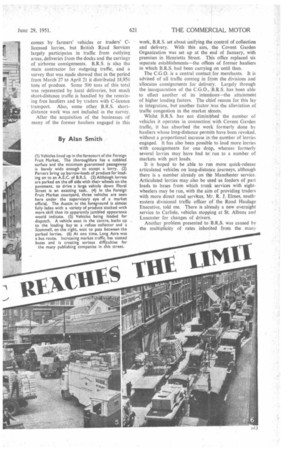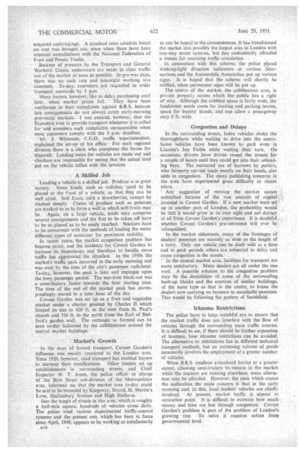By Alan Smith p ARLIAMENTARY and public outcries against fruit and
Page 71

Page 70

Page 72

If you've noticed an error in this article please click here to report it so we can fix it.
vegetable prices focus attention upon the market through which possibly the greatest proportion of the Nation's greenstuffs pass—Covent Garden. Probably about 500,000 tons are taken into and out of "the Garden" in a year and all, of course, by road.
Most of Covent Garden's supplies come in from London docks, but a high proportion is brought in from growers in the Home Counties, or farther afield. Most Continental produce comes up from the ferry , ports for collection at railheads, such as Nine Elms, but, to-day, many loads are flown over to Northolt, Blackbushe or other airports near London.
Much of the home produce taken into the market
comes by farmers' vehicles or traders' Clicensed lorries, but British Road Services largely participates in traffic from outlying areas, deliveries from the docks and the carriage of airborne consignments. B.R.S. is also the main contractor for outgoing traffic, and a survey that was made showed that in the period from March 27 to April 21 it distributed 18,95C, tons of produce. Some 500 tons of this total was represented by local deliveries, but much short-distance traffic is handled by the remaining free hauliers and by traders with C-licence transport. Also, some other B.R.S. shortdistance work was not included in the survey.
After the acquisition of the businesses of many of the former hauliers engaged in this work, B.R.S. set about unifying the control of collection and delivery. With this aim, the Covent Garden Organization was set up at the end of January, with premises in Henrietta Street. This office replaced six separate establishments—the offices of former hauliers in which B.R.S. had been carrying on until then.
The C.G.O. is a central contact for merchants. It is advised of all traffic coming in from the divisions and allocates consignments for delivery. Largely through the inauguaration of the C.G.O., B.R.S. has been able to effect another of its intentions—the attainment of higher loading factors. The chief reason for this lay in integration, but another factor was the alleviation of traffic congestion in the market streets.
Whilst B.R.S. has not diminished the number of vehicles it operates in connection with Covent Garden traffic, it has absorbed the work formerly done by hauliers whose long-distance permits have been revoked, without a proportional increase in the number of lorries engaged. It has also been possible to toad more lorries with consignments for one drop, whereas formerly several lorries may have had to run to a number of markets with part loads.
It is hoped to be able to run more quick-release articulated vehicles on long-distance journeys, although there is a number already on the Manchester service. Articulated lorries may also be used as feeders of part loads to bases from which trunk services with eightwheelers may be run, with the aim of providing traders with more direct road services, Mr. R. T. Elmes, southeastern divisional traffic officer of the Road Haulage Executive, told me. There is already a new overnight service to Carlisle, vehicles stopping at St. Albans and Lancaster for changes of drivers.
Another problem presented to B.R.S. was caused by the multiplicity of rates inherited from the many acquired undertakings. A standard rates schedule based on cost was brought out, since when there have been constant consultations with the National Federation of Fruit and Potato Trades.
Because of pressure by the Transport and General Workers' Union, endeavours are made to clear traffic out of the market as soon as possible. In pre-war days, there was no such rule and late-night working was common. To-day, customers are requested to order transport outwards by 3 p.m.
Many buyers, however, like to delay purchasing until later, when market prices fall. They have been vociferous in their complaints against B.R.S. because late consignments do not always catch early-morning provincial markets. I was assured, however, that the Executive tries to provide transport whenever it is called for and considers such complaints unreasonable when most customers comply with the 3 p.m. deadline.
Mr. J. Whiteside, C.G.O. traffic superintendent, explained the set-up of his office. For each regional division there is a clerk who completes the forms for dispatch. Loading notes for vehicles are made out and checkers are responsible for seeing that the actual load put on the vehicle tallies with the invoices.
A Skilled Job
Loading a vehicle is a skilled job. Produce is in great variety. Some kinds, such as radishes, need to be placed at the front of a vehicle, so that they can be well aired. Soft fruits, such a strawberries, cannot be stacked steeply. Crates of produce such as potatoes are stacked so as to form a well in which soft fruits may lie. Again, on a large vehicle, loads may comprise several consignments and the first to be taken off have to be so placed as to be easily reached. Stackers have to be conversant with the methods of loading the many different types of container for maximum stability. In recent years, the market congestion problem has become acute, and the tendency for Covent Garden to increase its importance and therefore to handle more traffic has aggravated the situation. In the 1930s the market's traffic peak occurred in the early morning and was over by the time of the city's passenger rush-hour. To-day, however, the peak is later and impinges upon the busy passenger period. The war-time black-out was a contributory factor towards the later starting time. The time of the end of the market peak has correspondingly moved to a later hour of the day.
Covent Garden was set up as a fruit and vegetable market under a charter granted by Charles II which limited its size to 420 ft. to the west from St. Paul's church and 316 ft. to the north from the Earl of Bedford's garden wall. The rectangle so formed can be seen to-day indicated by the cobblestones around the central market buildings.
Market's Growth
In the days of horsed transport, Covent Garden's influence was mainly restricted to the London area. Since 1920, however, road transport has enabled buyers to increase their ramifications. Other traders set up establishments in surrounding streets, and Chief Inspector W. T. Jones, the police officer in charge of the Bow Street sub-division of the Metropolitan area, informed me that the market area to-day could be said to be bounded by Kingsway, Strand, St. Martin's Lane, Shaftesbury Avenue and High Holborn.
Into the tangle of streets in this area, which is roughly a half-mile square, hundreds of vehicles come daily. The police tried various experimental traffic-control systems and the present one, which has been in force since April, 1948, appears to be working as satisfactorily n14 as can be hoped in the circumstances. It has transformed the market into possibly the largest area in London with one-way street systems, but has undoubtedly afforded a means for retaining traffic circulation.
In connection with this scheme, the police placed winking-light direction indicators at various intersections and the Automobile Association put up various signs. It is hoped that the scheme will shortly be ratified, when permanent signs will be put up.
The centre of the market, the cobblestone area, is private property across which the public has a right of way. Although the cobbled space is fairly wide, the landowner needs room for loading and parking lorries, space for buyers' stands, and can allow a passageway only 8 ft. wide.
Congestion and Delays
In the surrounding streets, laden vehicles choke the thoroughfares while waiting to drive into the centre. Some vehicles have been known to park even in Lincoln's Inn Fields while waiting their turn. On occasions, drivers have driven round the streets for a couple of hours until they could get into their unloading bays. The increased use of barrows by porters, who formerly carried loads mostly on their heads, also adds to congestion. The many publishing concerns in the area have experienced great difficulty in recent years.
• Any suggestion of moving the market comes unhitched because of the vast amount of capital invested in Covent Garden. If a new market were set. up in another part of London, the probability would be that it would grow in its own right and not detract at all from Covent Garden's importance. It is doubtful . whether Covent Garden's pre-eminence will ever be relinquished.
In the market sidestreets, many of the frontages of dealers' premises are scarcely as wide as the length of a lorry. Only one vehicle can be dealt with at a time and at peak periods others are subjected to delay and cause congestion in the streets.
' In the central market area, facilities for transport are more satisfactory. Many dealers are all under the one roof. A possible solution to the congestion problem may be the demolition of some of the surrounding built-up blocks and the erection of similar buildings, of the same type as that in the centre, to house the dealers now carrying on business in unsuitable premises. This would be following the pattern of Smithfield.
Irksome Restrictions
The police have to keep watchful eye to ensure that the market traffic does not interfere with the flow of vehicles through the surrounding main traffic arteries. It is difficult to see, if there should be further expansion of business, how irksome restrictions can be avoided. The alternative to restrictions lies in different technical transport methods, but an increasing volume of goods necessarily involves the employment of a greater number of vehicles.
When B.R.S. employs articulated lorries to a greater extent, allowing semi-trailers to remain in the market while the tractors are running elsewhere, some alleviation may be afforded. However, the peak which causes the authorities the main concern is that in the early morning and, in this, local traders' vehicles are chiefly involved. At present, market traffic is almost at saturation point. It is difficult to estimate how much money and time are lost through congestion. Covent Garden's problem is partof the problem of London's growing size. To solve it requires action from governmental level.












































































































































